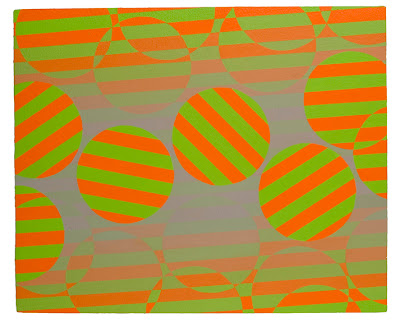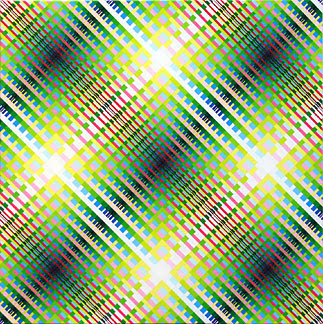Hartmut Bohm,
Paul Corio, Daniel Crews,
Matthew Deleget,
Lynne Harlow,
Gilbert Hsiao,
Changha Hwang,
Susanne Jung,
Steve Karlik,
Rossana Martinez,
Charlotte Nicholson, Francisca Reyes,
Steven Salzman,
Martjin Schuppers, Mike Stack,
Don Voisine. Curated by Gabriele Evertz, w. John Cox and
Abbey Ryan. For artnet Magazine review by
Stephen Maine click here. Click here for
installation shots.
 Paul Corio, BC Juvenile
Paul Corio, BC Juvenile, acrylic on panel, 8.5" x 10.5", 2006
Presentational Painting is a term coined by Sanford Wurmfeld. In the catalog to an earlier exhibiton of Presentional Painting in 1993, he wrote:
"Presentational art...refers to art structured by a human being and presented as a statement, a visual fact, to be expereienced or received by an active viewer. By its sensory nature, such art is untranslatable and the ideas or feelings transmitted by it are tied to the particular object that expresses them."
Still earlier, in 1985 in an exhibition for a show entitled "Color Documents: A Presentational Theory" he wrote:
Presentational Painting is a strain of modern art that originated around 1920 when painting departed entirely from reproduction and thus representation of the object. It stands at opposite ends to abstraction and must be distinguished from it since abstraction denotes art that does not relinquish its relationship to the exterior. But it is important to note that abstraction paved the way for a greater consideration of the role of viewer participation. By definition Presentational Painting is concerned with the account of meaning that is inherent in the painting itself. It is an art that has persisted in the face of resistance and has held its own against many other styles. The specialized approach to concentrating on perceptual phenomena, clarity of its organizing principles and affinity to logic gives rise to pictorial effects that are surprising despite its grounding in calculability and foresight. The pictorial possibilities are still expanding. The striking spatial and kinetic aspects of color interactions are especially astounding to observe. It is this consistency of the search for innovation and diversity that gives the practice its vitality. But to ensure continuation it requires the rethinking and reworking of the critical criteria that informs our expectation for this mode of expression today. "
"...it is the manipulation by the artist of the physical variables--the paint quality, the flat surface, and the size and shape of the support--together with an understanding of the relation of these variables to predictable visual structures, that is fundamental to esthetic meaning in paintings, and the basis of presentational art."


